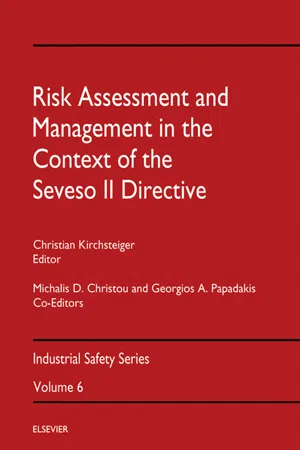
Risk Assessment and Management in the Context of the Seveso II Directive
- 534 pages
- English
- ePUB (mobile friendly)
- Available on iOS & Android
Risk Assessment and Management in the Context of the Seveso II Directive
About This Book
The assessment and management of risk to society from the operation of chemical process plants and other industrial activities in which dangerous substances are produced, used, handled or stored will remain a topic of great importance in the next decade. In order to evaluate this specific risk on a qualitative and/or quantitative basis, the concepts of risk analyses are linked together in this book.
The "performance based" and "goal oriented" regulatory requirements of the European Council's new "Seveso II Directive" for the identification of large scale industrial hazards, prevention of sudden and uncontrolled releases of dangerous substances from industrial plants and mitigation of serious consequences of industrial accidents to people and the environment are examined. The fact that risk assessment and management are key elements to such forms of regulation is also demonstrated.
While the "Seveso II Directive" defines "what" has to be achieved on the control of major hazards involving dangerous substances within the European Union, the methods of risk assessment and management give guidance on "how" to achieve it. The text provides a practical guide for decision-makers in regulatory bodies and companies with a non-technical background. Scientists and engineers who are not yet familiar with the concepts of risk assessment and who want a survey of some fundamentals of, and principal results from, risk assessment studies and approaches primarily for applications in the context defined by the "Seveso Directives" will also find this book invaluable.
Frequently asked questions
Information
Lessons Learned from Past Accidents
1. Objective and Introduction
Table of contents
- Cover image
- Title page
- Table of Contents
- Industrial Safety Series
- Front Matter
- Copyright page
- Dedication
- Abstract
- Foreword
- Summary and Structure
- Acknowledgement
- The Authors
- Disclaimer
- I. Introduction & Legal Framework
- II. Risk Assessment
- III. Risk Management
- IV. Implementation of the Seveso Directive
- V. Appendices